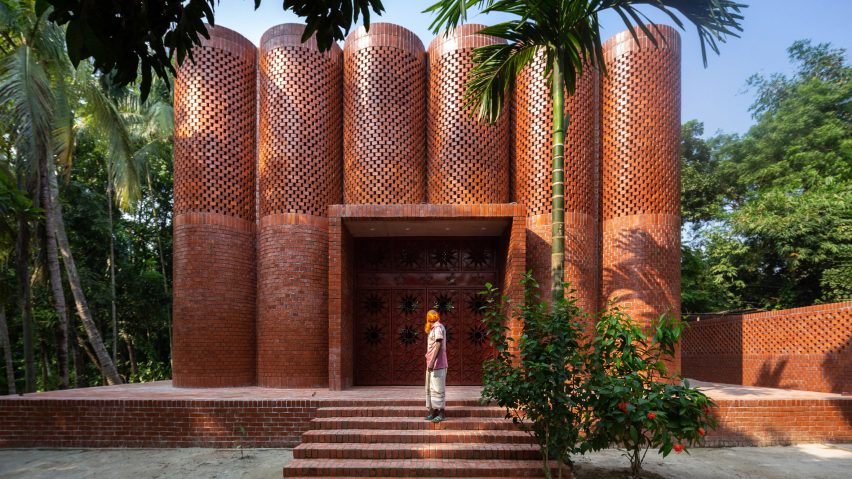A series of cylindrical skylights and brick turrets feature in this Bangladesh mausoleum, which architecture studio Sthapotik designed as a reference to traditional Islamic buildings.
Named the Shah Muhammad Mohshin Khan Mausoleum, the turreted brick volume was designed as a Dargah, or shrine, to house the graves of a local religious leader's family.
"Meaning 'portal' in Persian, a Dargah is a home for the grave of a revered religious figure," said Sthapotik.
"Metaphorically, the Dargah is the home for the earthly body," the studio continued.
Drawing upon the image of the chandelier, Dhaka-based studio Sthapotik topped the mausoleum with a ceiling of cylindrical skylights that stretch down into the space.
"The core concept was crafting the 'chandelier of paradise', which blesses the souls with the light of paradise for their noble work on earth," principal architect Sharif Uddin Ahammed told Dezeen.
Square-shaped in plan, the building is formed from four walls each comprising six cylindrical turrets with perforations towards the top for ventilation.
The turreted walls are made from red bricks that were sourced from a nearby brick field, paying homage to the traditional architecture of the region.
"We were highly inspired by the square-plan mosques of Bengal's Sultani Period and tried to transform the essence of that period in a contemporary way which is highly rooted in Bengali mosque architecture," said Ahammed.
Approached from a path that leads to the corner of the building, the mausoleum is built on top of a raised brick plinth to avoid flooding. It is accessed by a series of steps, with a ramp providing additional access to one side of the site.
Four doors made from locally sourced iron bars and sheets offer entry points on each face of the building and feature patterns informed by Islamic motifs.
"The pattern on the doors is inspired by Islamic motifs and design," said Ahammed. "The star on the gate represents five family members of the prophet where Allah remains in the middle, while the cuttings in the pattern allow for ventilation and visibility when the door is closed."
Inside, three graves for the owner's family are raised on a square-shaped marble platform at the centre of the room, with a fourth space left empty for the owner of the project.
"Marble is considered a precious material and is used in a lot of famous Islamic architecture in this subcontinent," said Ahammed. "White marble was chosen because the colour white is the symbol of peace and its reflective quality lights up the whole interior."
Designed to mimic multi-domed mosques, a ceiling featuring a grid of thirty-six circular openings lets light into the interior.
Sixteen of the openings at the centre of the ceiling have been stretched down into the space to form a chandelier-informed arrangement of skylights over the central plinth.
"The circular punches and hanging cylindrical droppings from the waffle roof all together appear in a dynamic chandelier, letting natural light seep into the Dargah and create a natural pattern on the floor," said the studio.
Other mausoleums featured on Dezeen include an Adolf Loos-designed tomb built in a historic London cemetery and a marble installation that was on display at Milan Design Week in 2017.
The photography is by Asif Salman.

